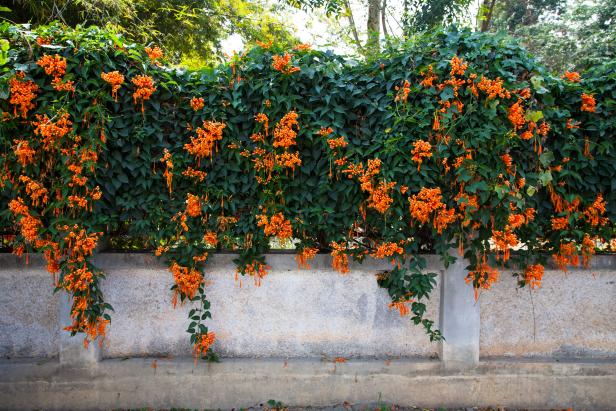Small Trees for Pots: Perfect Choices for Compact Spaces
Small trees for pots are a great way to add greenery and life to any indoor or outdoor space. Whether you have limited outdoor space, want to add some greenery to your balcony or patio, or simply want to bring some nature indoors, small trees in pots are a versatile and easy solution.
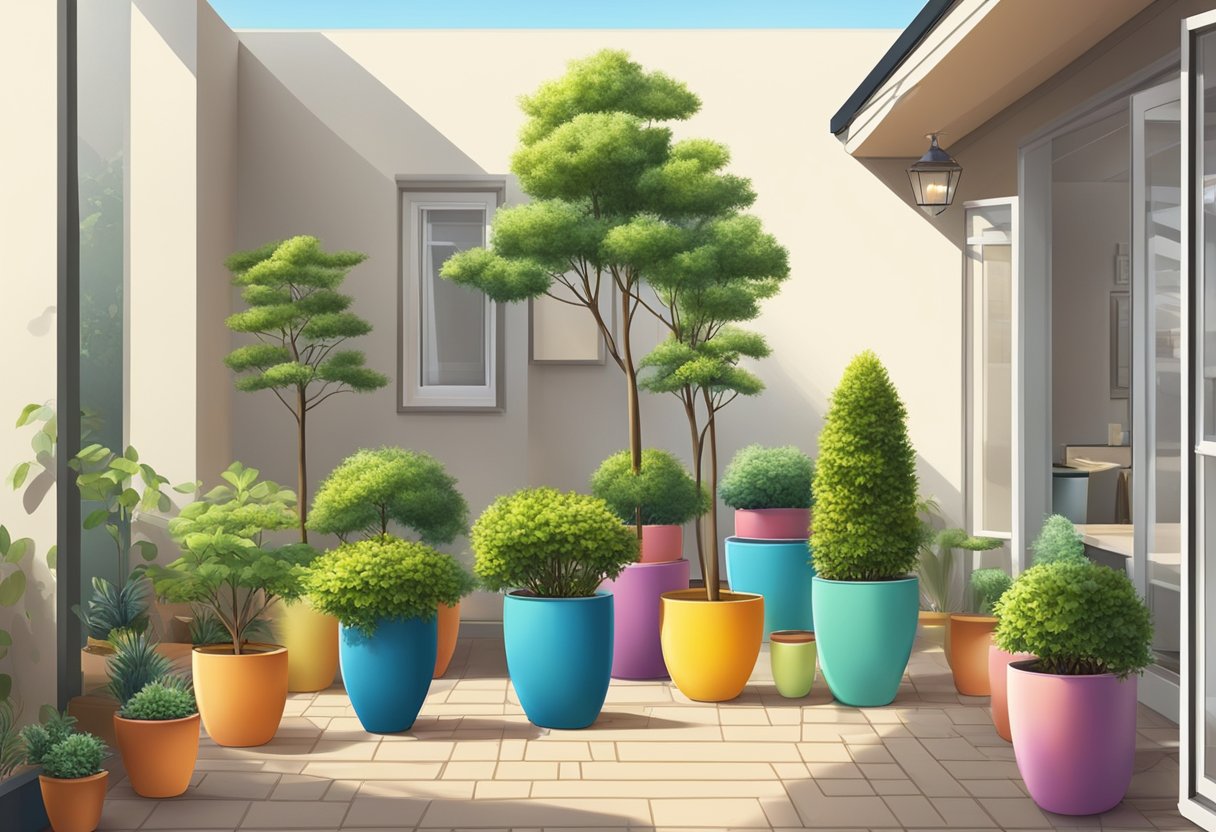
When it comes to choosing small trees for pots, there are many options to consider. Some popular choices include citrus trees like lemon or lime, dwarf fruit trees such as apple or cherry, and ornamental trees like Japanese maple or dwarf conifers. The key is to choose a tree that is well-suited to the size of your pot and the conditions of your space, such as the amount of sunlight and humidity.
In this article, we will explore the best small trees for pots, taking into account factors such as size, care requirements, and aesthetic appeal. Whether you are a seasoned gardener or a beginner, we hope to provide you with the knowledge and confidence to choose the perfect small tree for your pot and enjoy the beauty and benefits of nature in your home or outdoor space.
Choosing the Right Pots
When it comes to growing small trees in pots, choosing the right pots is crucial. The right pot can ensure that your tree thrives and grows healthy, while the wrong pot can lead to stunted growth, poor health, and even death. In this section, we will discuss the key factors to consider when choosing pots for your small trees.
Pot Size and Material
The size of the pot you choose will depend on the size of your tree and how much space it needs to grow. If you choose a pot that is too small, your tree’s roots will become cramped, and it will not be able to absorb the nutrients it needs to grow. On the other hand, if you choose a pot that is too large, your tree may struggle to absorb water, and the excess soil can become waterlogged, leading to root rot.
In general, a good rule of thumb is to choose a pot that is at least twice the size of your tree’s root ball. This will give your tree enough room to grow and spread its roots. As for material, clay pots are a popular choice for container gardens, as they are porous and allow for good airflow to the roots. However, they can be heavy and breakable. Plastic pots are lightweight and durable, but they may not allow for as much airflow as clay pots.
Drainage Considerations
Good drainage is crucial when it comes to growing small trees in pots. If your pot does not have adequate drainage, excess water can accumulate at the bottom of the pot, leading to root rot and other problems. When choosing a pot, make sure it has drainage holes at the bottom to allow excess water to escape.
In addition to having drainage holes, it is also important to use well-draining soil in your container garden. This will help ensure that excess water can escape the pot, rather than becoming trapped in the soil. You can purchase well-draining soil at most garden centers, or you can make your own by mixing sand, perlite, and peat moss.
By considering pot size and material, as well as drainage considerations, you can choose the right pots for your small trees and help ensure that they grow healthy and strong.
Selecting Small Trees for Pots
When it comes to selecting small trees for pots, there are several factors to consider, such as the tree’s size, growth rate, and water requirements. In this section, we will explore some of the best small trees for pots, divided into four subsections: Evergreen Varieties, Deciduous Choices, Fruit-Bearing Trees, and Ornamental Trees.
Evergreen Varieties
Evergreen trees are a great choice for potted trees as they retain their leaves year-round, providing year-round greenery. Some popular evergreen varieties for pots include the Japanese Maple, Olive Trees, and Citrus Trees. Japanese Maples are a popular choice for their delicate leaves and stunning colors. Olive Trees are a hardy evergreen that can adapt to various climates and soil types. Citrus Trees are perfect for those who want a tree that not only looks great but also produces fruit.
Deciduous Choices
Deciduous trees are a great option for those who want to enjoy the changing seasons. Some popular deciduous choices for potted trees include the Amelanchier, which produces stunning white flowers in the spring and beautiful foliage in the fall. Another great choice is the Dwarf Varieties of Deciduous Trees, such as the Dwarf Japanese Maple, which is an excellent option for those who want a small tree with stunning foliage.
Fruit-Bearing Trees
Fruit-bearing trees not only look great in pots but also provide a source of fresh fruit. Some popular fruit-bearing trees for pots include Citrus Trees, which produce a variety of fruits such as lemons, limes, and oranges. Another great option is the Dwarf Fruit Trees, such as Dwarf Apple Trees, which are perfect for small spaces and produce delicious fruit.
Ornamental Trees
Ornamental trees are a great way to add a pop of color to your outdoor space. Some popular ornamental trees for pots include Conifers, which come in a variety of shapes and sizes, providing year-round interest. Another great option is Flowering Trees, such as the Dogwood Tree, which produces stunning flowers in the spring and beautiful foliage in the fall.
In conclusion, when selecting small trees for pots, it is essential to consider the tree’s size, growth rate, and water requirements. By considering these factors and exploring the different varieties of trees available, you can find the perfect small tree for your outdoor space.
Tree Care in Pots

When it comes to growing small trees in pots, proper care is essential to ensure they thrive. This section will cover the four main aspects of tree care in pots: watering requirements, soil and compost, sunlight and placement, and fertilizing and pruning.
Watering Requirements
One of the most important aspects of caring for small trees in pots is ensuring they receive adequate water. It is important to avoid overwatering, as this can lead to root rot and other issues. On the other hand, underwatering can cause the tree to dry out and die.
To determine when to water your tree, check the soil moisture level by sticking your finger about an inch into the soil. If it feels dry, it is time to water. It is also important to ensure that the pot has proper drainage to prevent water from accumulating and causing root rot.
Soil and Compost
The soil and compost used in a pot can have a significant impact on the health of a small tree. It is important to use a high-quality potting mix that is well-draining and nutrient-rich. Adding compost can also help improve soil quality and provide essential nutrients to the tree.
When repotting a tree, make sure to use a pot that is slightly larger than the current one to allow for root growth. It is also important to avoid compacting the soil too tightly, as this can prevent water from draining properly.
Sunlight and Placement
Small trees in pots require plenty of sunlight to grow and thrive. They should be placed in a location that receives full sun for at least six hours per day. If the tree is kept indoors, it should be placed near a south-facing window to ensure it receives adequate sunlight.
When placing a tree on a patio or balcony, make sure to choose a location that is protected from strong winds and extreme temperatures. It is also important to ensure that the pot is stable and will not tip over in windy conditions.
Fertilizing and Pruning
Fertilizing and pruning are important aspects of caring for small trees in pots. Fertilizer should be applied according to the instructions on the package, usually every four to six weeks during the growing season. Pruning should be done to remove dead or damaged branches and to shape the tree as desired.
It is important to avoid over-fertilizing or over-pruning, as this can damage the tree and inhibit growth. Regular maintenance and care can help ensure that small trees in pots remain healthy and vibrant for years to come.
Special Considerations
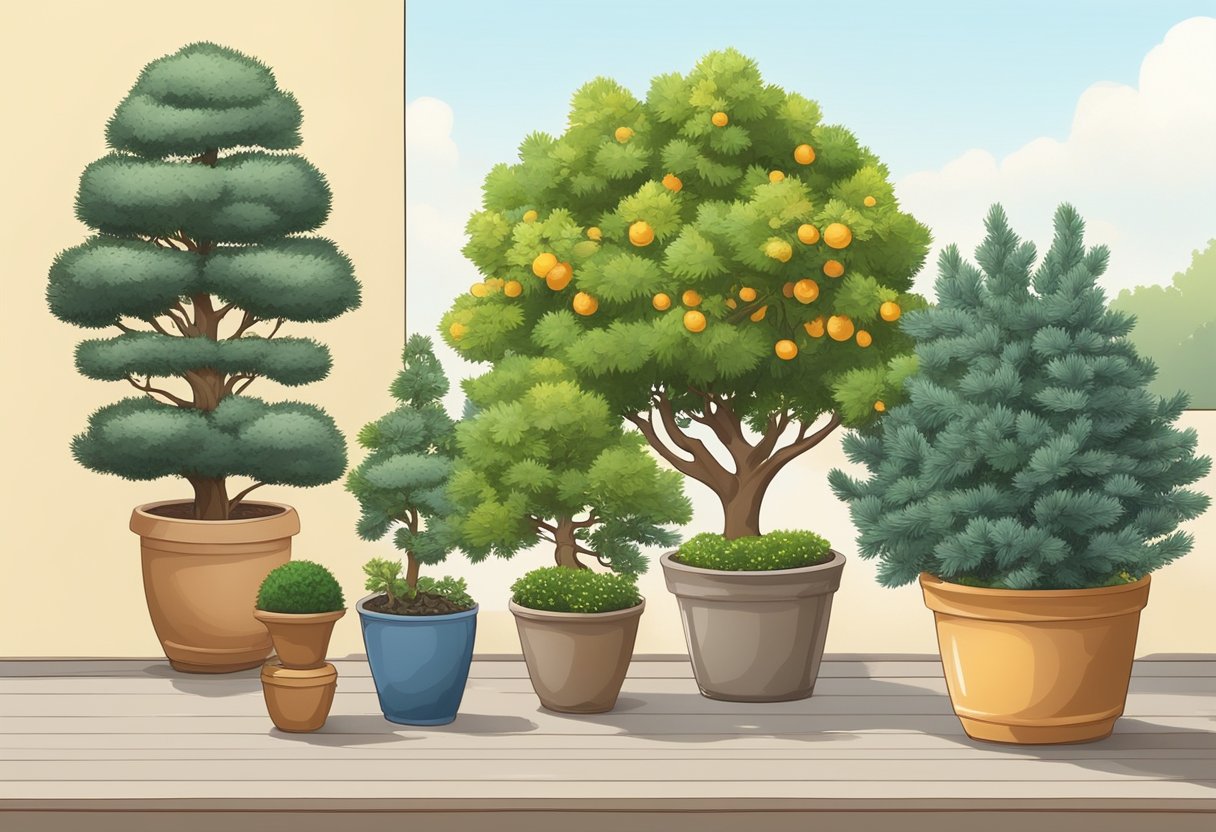
Dwarf and Slow-Growing Trees
When it comes to small trees for pots, dwarf and slow-growing trees are a great option. They are perfect for those who want to add a touch of greenery to their patio or balcony without taking up too much space. The dwarf mugo pine, for example, is a great choice for those who want a tree that will stay small and compact. It’s also a slow-growing tree, which means it won’t outgrow its pot too quickly.
Self-Fertile and Pollinator-Friendly Trees
If you want a small tree that will produce fruit, consider self-fertile trees. These trees don’t require another tree for pollination and are perfect for small spaces. The dwarf cherry tree is a great example of a self-fertile tree that can be grown in a pot. It produces sweet cherries and is also pollinator-friendly, meaning it will attract bees and other beneficial insects to your garden.
Trees for Privacy and Aesthetics
If you’re looking for a small tree that will provide some privacy or add some visual interest to your outdoor space, there are several options to choose from. The dwarf Japanese maple, for example, is a beautiful tree that can be grown in a pot. It’s also a slow-growing tree, which means it won’t outgrow its pot too quickly. Another option is the dwarf arborvitae, which is a great choice for those who want a tree that will provide some privacy. It’s a slow-growing tree that can be easily pruned to maintain its shape and size.
Overall, when choosing small trees for pots, it’s important to consider the specific needs of the tree and the space in which it will be grown. With the right care and attention, small trees can thrive in pots and add beauty and interest to any outdoor space.
Common Small Trees for Pots

Growing small trees in pots is a great way to add greenery to your balcony, patio, or any small space. Small trees in pots are low-maintenance, and they can be moved around easily. Here are some of the most common small trees that can be grown in pots:
Citrus Varieties
Citrus trees are a popular choice for pots because they are easy to grow and maintain. Lemon trees, in particular, are a great option for those who love fresh citrus fruit. Olive trees are another citrus variety that can be grown in pots. They are drought-tolerant and can thrive in small spaces.
Popular Evergreens
Evergreen trees are a great option for those who want greenery all year round. Acer palmatum, also known as Japanese maple, is a popular choice for pots because of its beautiful foliage. It is a slow-growing tree that can add a touch of elegance to any outdoor space. Another popular evergreen tree is the olive tree. It is a hardy tree that can thrive in a variety of conditions.
Flowering and Foliage Trees
Flowering and foliage trees are a great way to add color and texture to your outdoor space. Flowering dogwood is a popular choice for pots because of its beautiful flowers. It is a low-maintenance tree that can thrive in small spaces. Starry magnolia is another flowering tree that can be grown in pots. It has beautiful star-shaped flowers that bloom in the spring.
In conclusion, growing small trees in pots is a great way to add greenery to your outdoor space. Citrus varieties, popular evergreens, and flowering and foliage trees are all great options for pots. With a little bit of care and attention, these trees can thrive in small spaces and add beauty to your outdoor area.
Pest and Disease Management

Small trees grown in pots are vulnerable to pests and diseases, just like any other plant. Here are some tips on how to manage them:
Pests
Some common pests that can affect small trees in pots include:
- Aphids: These small, soft-bodied insects suck sap from the leaves and stems, causing them to wilt and yellow. They can be controlled by spraying the tree with a strong jet of water or by using insecticidal soap.
- Spider mites: These tiny arachnids spin webs on the leaves and suck sap, causing leaves to yellow and drop. They can be controlled by spraying the tree with water or using a miticide.
- Scale insects: These small, hard-shelled insects attach themselves to the leaves and stems and suck sap. They can be controlled by using insecticidal soap or horticultural oil.
Regular inspection of small trees in pots can help detect pest infestations early, making control easier.
Diseases
Small trees in pots can also be susceptible to diseases, such as:
- Root rot: This fungal disease can be caused by overwatering or poor drainage. Symptoms include yellowing leaves and stunted growth. To prevent root rot, ensure the pot has adequate drainage and allow the soil to dry out between waterings.
- Leaf spot: This fungal disease causes small, dark spots on the leaves, which can merge and cause the leaf to drop. To prevent leaf spot, avoid overhead watering and ensure good air circulation around the tree.
- Powdery mildew: This fungal disease causes a white, powdery coating on the leaves and stems. It can be controlled by spraying the tree with a fungicide or by improving air circulation.
Regular sanitation, such as removing fallen leaves and debris, can also help prevent the spread of diseases.
By following these tips, small trees in pots can be kept healthy and free from pests and diseases.
Winter Care for Potted Trees
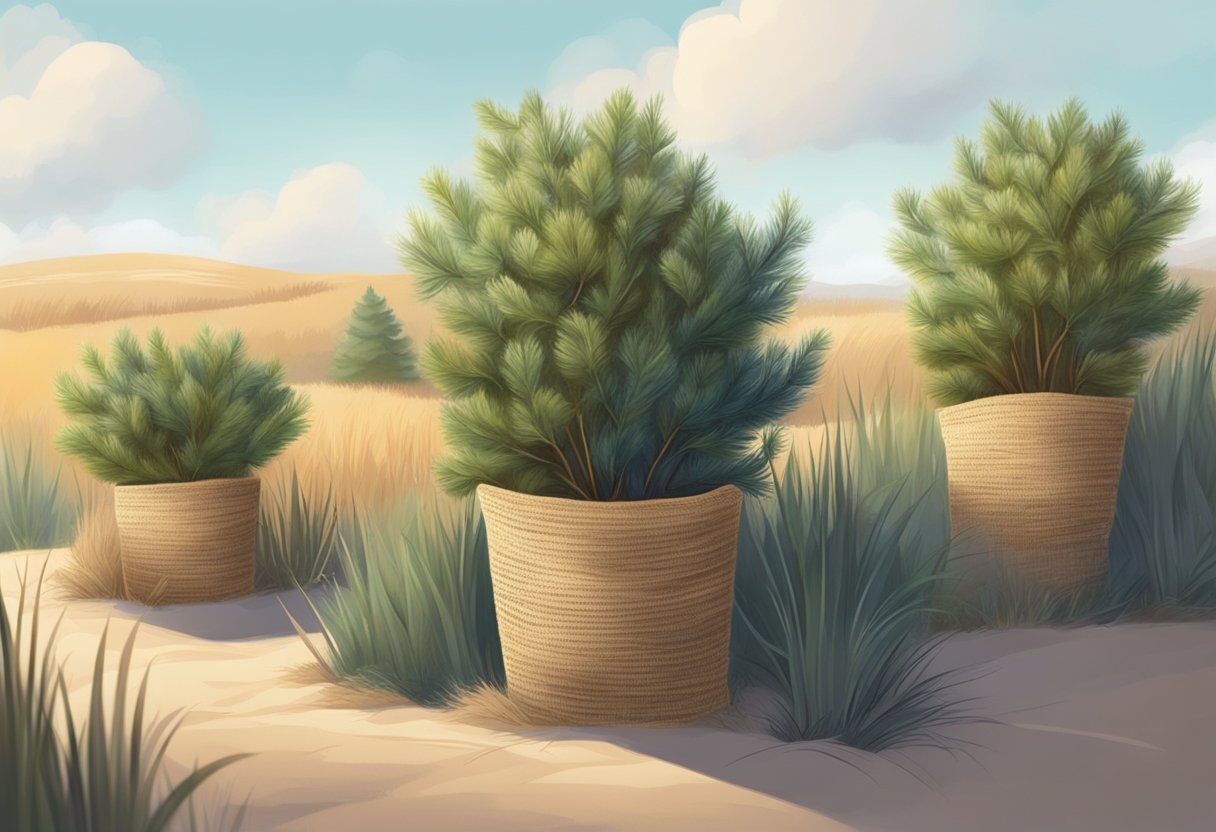
When it comes to caring for potted trees in winter, there are a few important things to keep in mind to ensure their survival. Here are some tips to help you keep your small trees healthy and happy during the cold months:
Cold Protection
One of the most important things you can do to protect your potted trees from the cold is to move them to a sheltered location. This could mean bringing them indoors, placing them in a greenhouse, or simply moving them to a spot that is protected from the wind and other harsh weather conditions.
You can also wrap your trees in burlap or other insulating materials to help protect them from the cold. Just be sure to leave some ventilation so that the trees don’t get too warm and moist, which can lead to fungal growth and other problems.
Winter Care
During the winter months, your potted trees will need less water than they do in the spring and summer. However, you should still check the soil regularly and water as needed to ensure that the trees don’t dry out completely.
You should also be on the lookout for pests and diseases, which can be more common in the winter months. Keep an eye out for signs of infestation, such as yellowing leaves, and take action as needed to prevent the problem from spreading.
Finally, be sure to prune your trees as needed to keep them healthy and looking their best. This can help prevent disease and other problems, and can also help your trees grow stronger and more resilient over time.
By following these simple tips, you can help ensure that your potted trees stay healthy and happy throughout the winter months. With a little bit of care and attention, your small trees can thrive and grow for years to come.
Additional Tips and Tricks
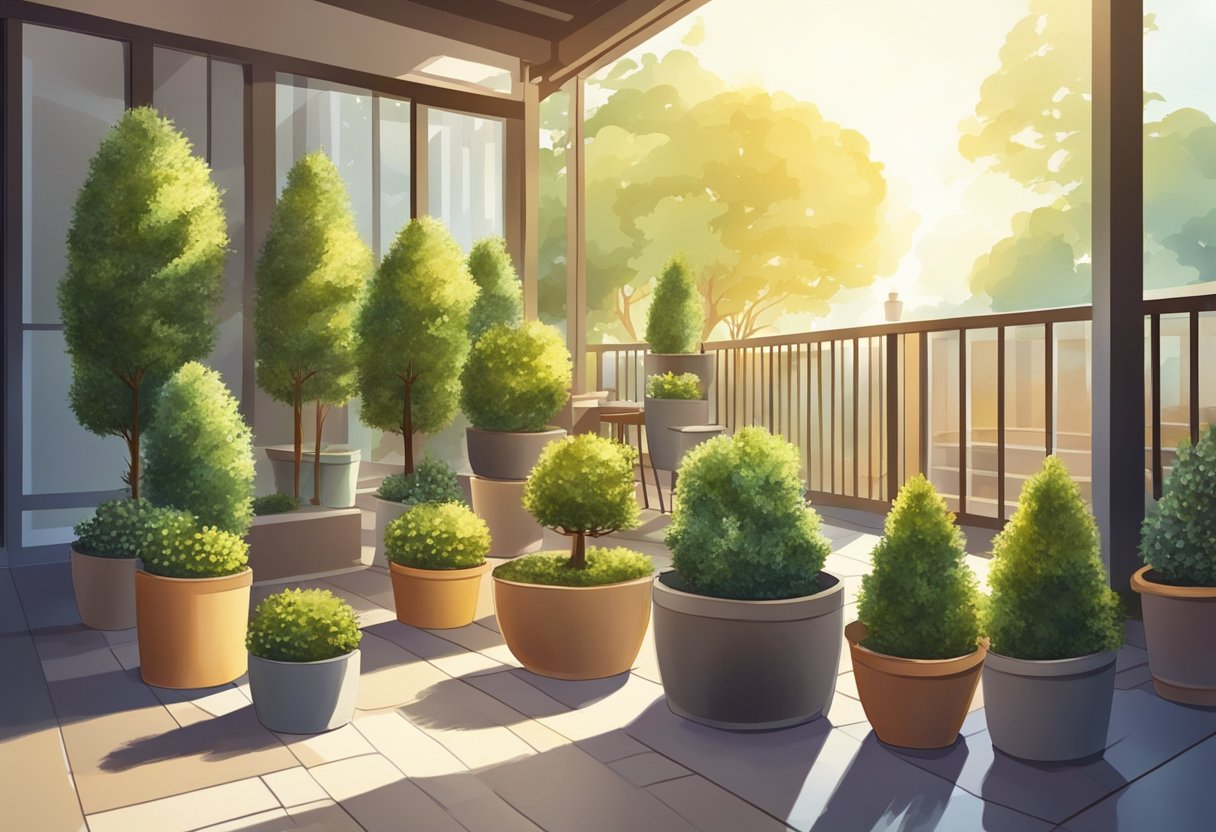
When it comes to small trees for pots, there are a few additional tips and tricks that can help ensure success. Here are some things to keep in mind:
Consider the plant’s water needs: While some small trees are drought-tolerant, others require regular watering. Be sure to research the specific needs of the tree you choose and adjust your watering schedule accordingly.
Choose the right soil: Some small trees prefer acidic soil, while others do better in alkaline soil. Make sure you know the pH requirements of your chosen tree and select soil that meets those needs.
Companion planting: Consider planting herbs or other plants that are beneficial to bees and butterflies alongside your small tree. This can help attract pollinators to your garden and create a more vibrant ecosystem.
Fertilize sparingly: While small trees in pots may require more frequent fertilization than those planted in the ground, it’s important not to overdo it. Too much fertilizer can damage the roots and cause the tree to become stressed.
Remember, the key to success with small trees in pots is to provide them with the right growing conditions and care. With a little research and attention to detail, you can create a beautiful and thriving garden filled with small trees.
Frequently Asked Questions
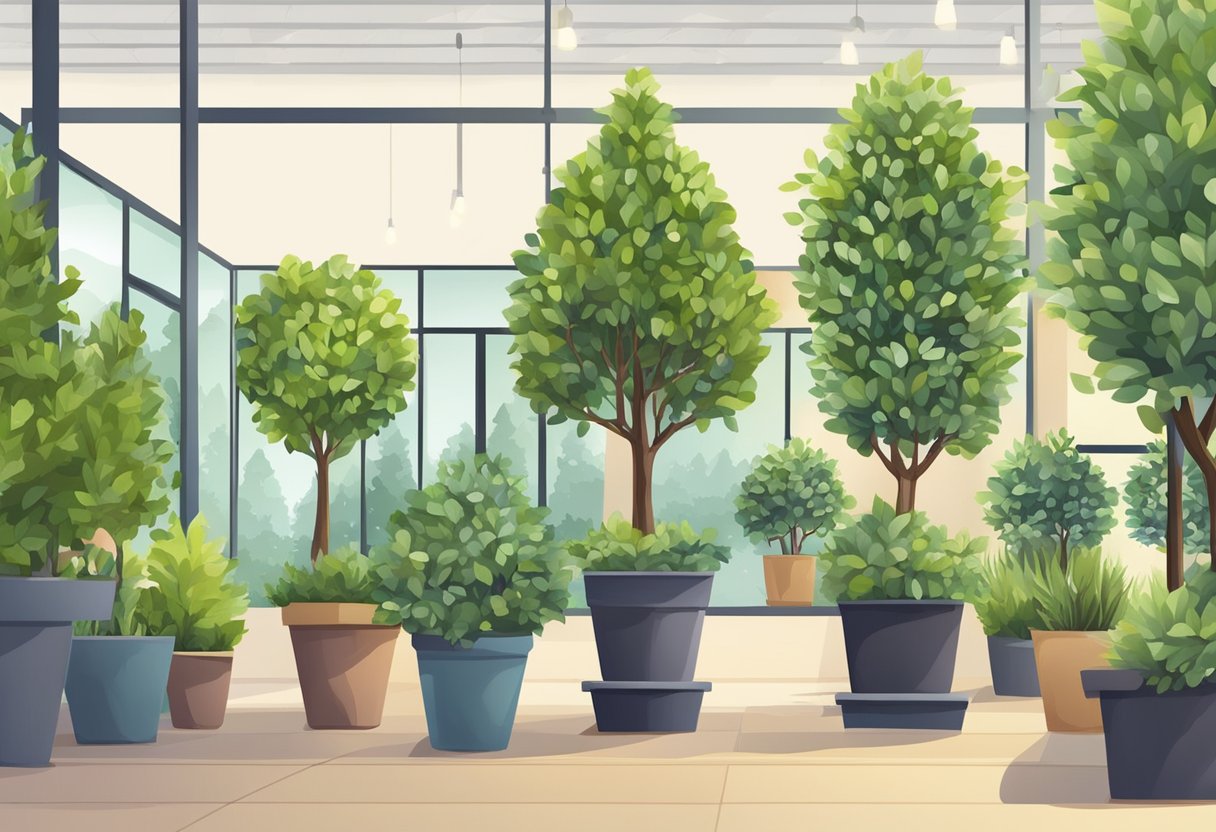
What are the top varieties of small trees suitable for growing in full sun conditions?
Some of the top varieties of small trees that can thrive in full sun conditions include Japanese maple, dogwood, redbud, crabapple, and dwarf citrus trees. These trees are known for their ability to withstand direct sunlight and can be grown in pots on patios, balconies, or decks.
Which dwarf trees are known for thriving in pots and maintaining a compact size?
Dwarf fruit trees like dwarf apple, peach, and cherry trees are ideal for growing in pots and maintaining a compact size. Other popular dwarf trees include dwarf Japanese maple, dwarf conifers, and dwarf weeping willows. These trees are perfect for small spaces and can add an ornamental touch to any outdoor area.
How can I ensure small trees survive in pots through winter in colder climates?
To ensure small trees survive in pots through winter in colder climates, it is important to choose trees that are hardy enough to withstand the cold. Trees like spruce, pine, and juniper are good options for colder climates. It is also important to provide adequate insulation by wrapping the pot with burlap or bubble wrap and placing it in a sheltered area.
What are the ideal small tree species for planting in containers in zone 5?
Some of the ideal small tree species for planting in containers in zone 5 include dwarf Alberta spruce, dwarf Korean lilac, and dwarf burning bush. These trees are able to tolerate the colder temperatures in zone 5 and can add color and texture to any outdoor space.
Can you recommend some small trees that are well-suited for shaded areas in containers?
Small trees that are well-suited for shaded areas in containers include Japanese maples, dwarf hydrangeas, and dwarf rhododendrons. These trees are able to thrive in partial to full shade and can add a lush and vibrant touch to any shaded area.
What are some attractive small trees to place at the front door in pots for curb appeal?
Attractive small trees to place at the front door in pots for curb appeal include topiary trees, dwarf evergreens, and ornamental grasses. These trees can add a welcoming touch to any home and can be easily maintained in pots.

